Recent Articles
Popular Makes
Body Types
2017 Jeep Grand Cherokee vs. 2017 Ford Explorer: Which is Best?
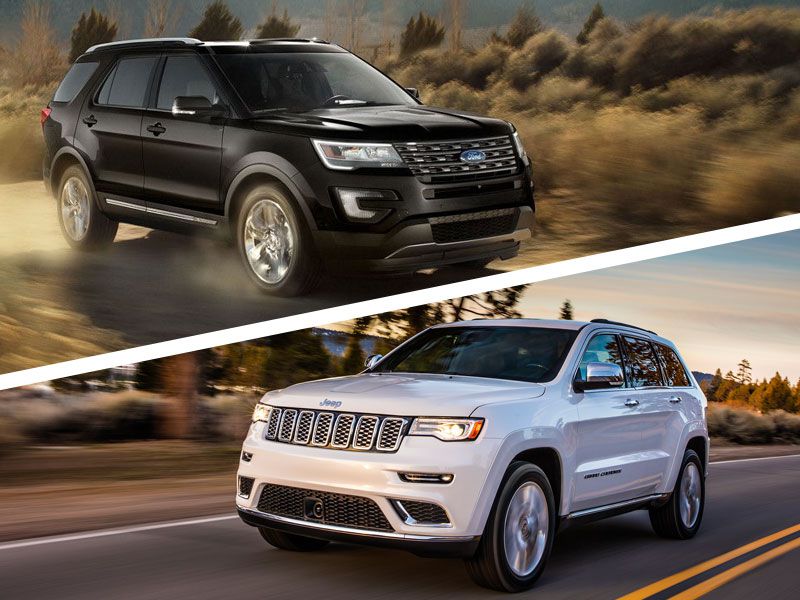
2017 Ford Explorer vs 2017 Jeep Grand Cherokee exterior on road ・ Photo by Ford / Jeep
Consumer demand for SUVs is high, and two of the most popular choices currently on the market are the 2017 Jeep Grand Cherokee and the 2017 Ford Explorer. Which is best, however, will depend a lot on your own specific needs. That’s because even though the Grand Cherokee and Explorer have their share of similarities, they provide two distinct ownership experiences.
On the one hand, both vehicles are award-winning sport-utilities with versatile cabins, plenty of available technology, and some impressively robust engine choices. That said, the Grand Cherokee is a midsize entry, which offers two rows of seating, while the Explorer is nearly 10 inches longer—with space to fit three rows. It’s a size differential that leads to some noticeable differences regarding functionality as well.
But is it enough to give the Ford an edge here? Let’s find out.
Exterior Design
The Grand Cherokee is positioned as the flagship of the Jeep brand with its somewhat restrained styling. While the vehicle does have a streamlined and sophisticated shape, details like the traditional seven-slot grille are downplayed, and its standard headlights are relatively nondescript. The Ford Explorer, on the other hand, is an SUV that looks the part, with a larger and more prominent front grille, plus a longer and stronger-looking hood. The Explorer also has standard LED low-beam headlamps and LED taillamps. The Jeep offers LED fog lamps and daytime running lamps for an extra cost, whereas the Ford serves up optional LED fog lamps of its own. With that in mind, the Explorer is the more attractive SUV on the exterior.

Photo by Ford
Interior Design
Moving inside, the cabins for the Grand Cherokee and the Explorer have some interesting traits in common, including detailed inner-door panels and center-stack interfaces that stem outward from the dashboard. The Jeep does start with a noticeably more premium standard environment than the Ford, with a contrast-color accent around that interface and on the steering wheel as one example. That’s to be expected since as mentioned, the Grand Cherokee is the most upscale of the Jeep SUVs and the Explorer is aimed more at the middle of the market. Perhaps surprising is the fact that the Ford does offer some high-end features like massaging front seats, a car-like feature that matches the Explorer’s car-like interior. But since we’re evaluating SUVs and not standard cars, we prefer the Grand Cherokee in this category.
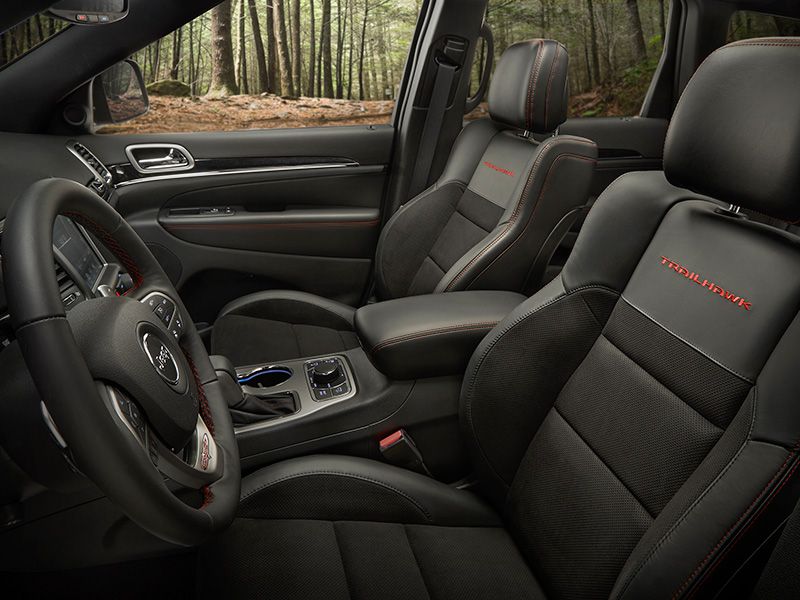
Photo by Jeep
Interior Versatility
The added length of the Ford Explorer we mentioned earlier (10 inches,) delivers an unbeatable benefit when it comes to both passenger and cargo volume. Thus the Blue Oval product not only fits two more occupants, thanks to the third row of seating that’s not available for the Jeep, it also has superior first and second-row headroom and legroom. Due to the added length, the Explorer also has a cargo capacity of 21 cubic feet behind its rear row, 43.9 cubic feet behind the second row, and 81.7 cubic feet total. The Grand Cherokee tops out with 68.3 cubic feet of storage total.
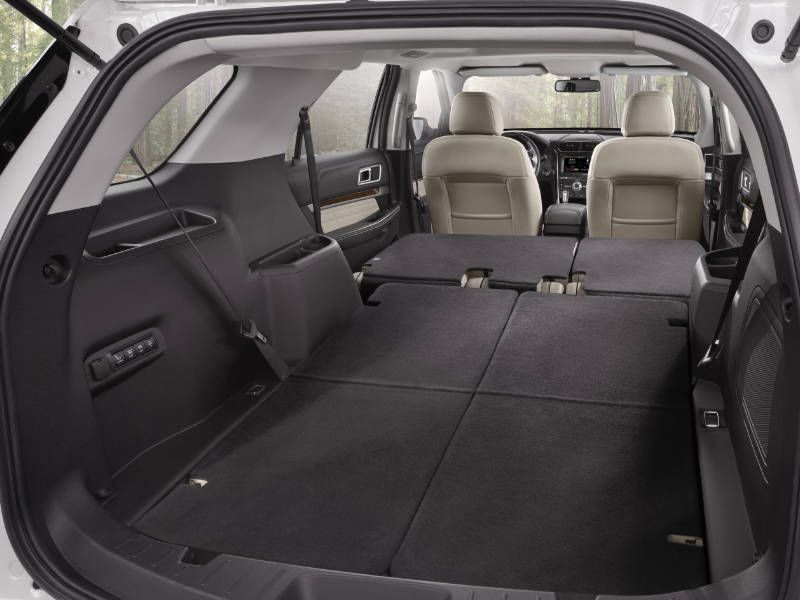
Photo by Ford
On-Road Performance
The Jeep Grand Cherokee takes the lead in the performance department starting with a more powerful standard engine, a 3.6-liter that makes 295 horsepower and 260 lb.-ft. of torque. For those looking for additional power, an upgrade to the SRT edition packs a massive 6.4-liter V8 that can unleash 475 horsepower and 470 lb.-ft. of torque. When examining the Explorer, the EcoBoost V6 in the Sport is limited to 365 horsepower and 350 lb.-ft. of torque. Also worth noting the upgrade in the Grand Cherokee to SRT trim level with a 5.7-liter HEMI V8 will have a towing capacity of up to 7,200 lbs.—more than a ton beyond the Explorer’s tow rating. And if you can hold out until the 2018 model year, you may be able to snag a new Trackhawk edition that uses the same 707-horsepower supercharged V8 as the Dodge Hellcat muscle cars. As the most powerful and quickest production SUV ever, expect the Trackhawk edition to leave the Explorer, and the rest of the competition, in its dust.

Photo by Jeep
Fuel Economy
About those fuel-efficiency grades: the Ford Explorer, as mentioned, leads the way with EPA ratings of up to 19 mpg city/27 mpg highway/22 mpg combined with its optional EcoBoost engine. Those are indeed relatively decent marks for a vehicle of its size, but they’re only a bit more than the standard EPA ratings of the smaller Jeep Grand Cherokee, which achieves 19 mpg city/26 mpg highway/21 mpg combined. Further, the best EPA line by a four-wheel-drive Grand Cherokee is identical to the top ratings for a similarly equipped Explorer (18 mpg city/25 mpg highway/21 mpg combined.) So although Ford’s SUV claims the win for fuel-economy, it probably won’t have much impact on the decision-making process.
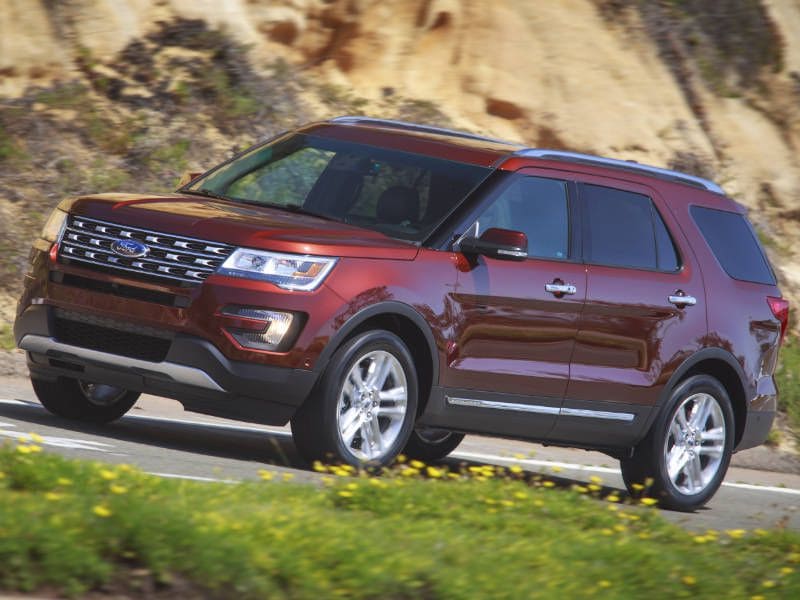
Photo by Ford
Off-Road Performance
Unsurprisingly, the Grand Cherokee also outshines the Explorer when it’s time to leave the pavement. In these scenarios, Ford owners rely on an available multi-mode “Intelligent 4WD” system with dedicated settings for normal conditions, mud, ruts, sand, and finally, one for looser surfaces such as snow, gravel, and grass.
The Jeep, for its part, showcases multiple four-wheel-drive setups along with a Trail Rated Trailhawk edition for serious rock crawlers. One of the most capable off-roaders in its class, the Trailhawk is the real deal and gets kitted out with a “Quadra-Drive 4X4” system, an electronic limited-slip differential at the rear, and a trail-tuned version of the Grand Cherokee’s air suspension.

Photo by Jeep
Technology and Safety
The Jeep Grand Cherokee and Ford Explorer both offer an extensive range of driver-assistance technology that includes a standard rearview camera plus options such as adaptive cruise control, forward collision warning, automatic braking, a blind-spot monitor, rear cross-traffic alert, lane-departure warning, parking assistance, and rain-sensing wipers. The Explorer also goes a bit further with an innovative set of inflatable seatbelts for the second-row outboard positions.
Another small but significant advantage for the Ford shows up in the government’s crash-test results. According to NHTSA, the Explorer and Grand Cherokee each have 5-Star Overall Safety Ratings in their four-wheel-drive configurations. That rating doesn’t change for two-wheel-drive Explorers, but the two-wheel-drive Grand Cherokee only earns a 4-Star Overall Safety Score.
The bottom line: count this as a victory for the Explorer.
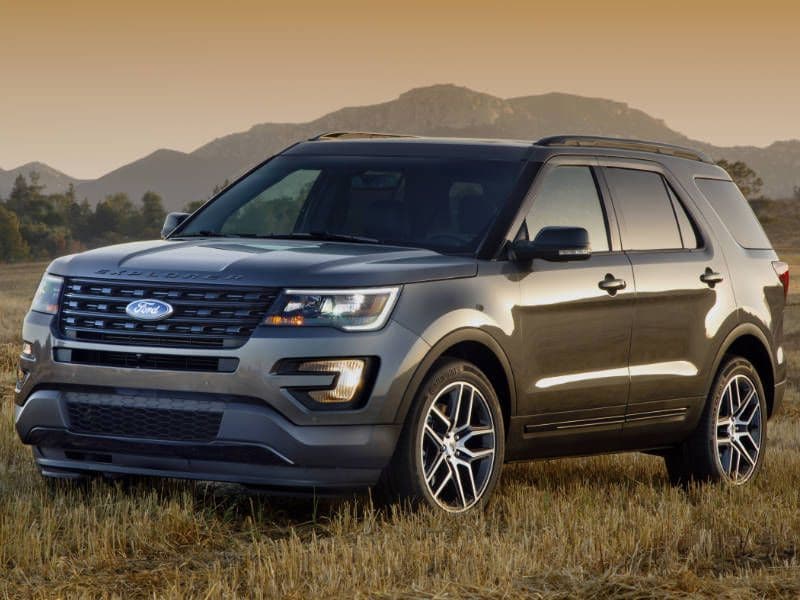
Photo by Ford
Pricing and Value
Going strictly by the numbers, the Grand Cherokee starts at $30,395 and the MSRP of the Explorer is $31,160, making the Jeep about 2.5 percent ($765) less expensive. Some of that can be attributed to Ford’s larger dimensions, of course, but you should keep in mind that the Grand Cherokee has more in the way of standard premium details. For instance, the entry price for the Jeep covers a leather-wrapped steering wheel, fog lamps, and heated exterior mirrors, all of which cost extra with the Explorer. Nor should you be fooled by Ford’s standard SYNC infotainment system—this is previous-generation technology, and the cutting-edge SYNC 3 setup is optional. As a result of all this, the Jeep has a slight budgetary advantage too.
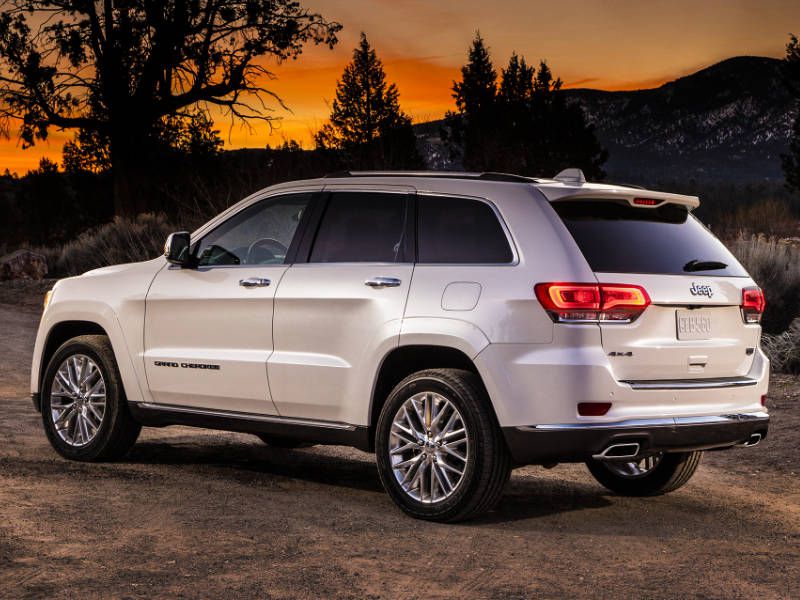
Photo by Jeep
Infotainment Features
The Grand Cherokee’s momentum also carries over when it’s time to compare infotainment technologies. Now the previously mentioned SYNC 3 system for the Ford is a significant advance in the past set up, and it does have a generously sized eight-inch touchscreen. Additionally, the Explorer supplies a premium Sony sound system.
The reasons we prefer the Jeep? It furnishes a range-topping, award-winning Uconnect system with a larger 8.4-inch touchscreen that can even be used to adjust the temperature of the front-row seats. In the mix as well for the Grand Cherokee: a seven-inch re-configurable info display on the instrument panel and two premium sound systems, including one by the audiophiles at Harman Kardon. This system boasts 825 watts of power and 19 high-efficiency GreenEdge speakers.
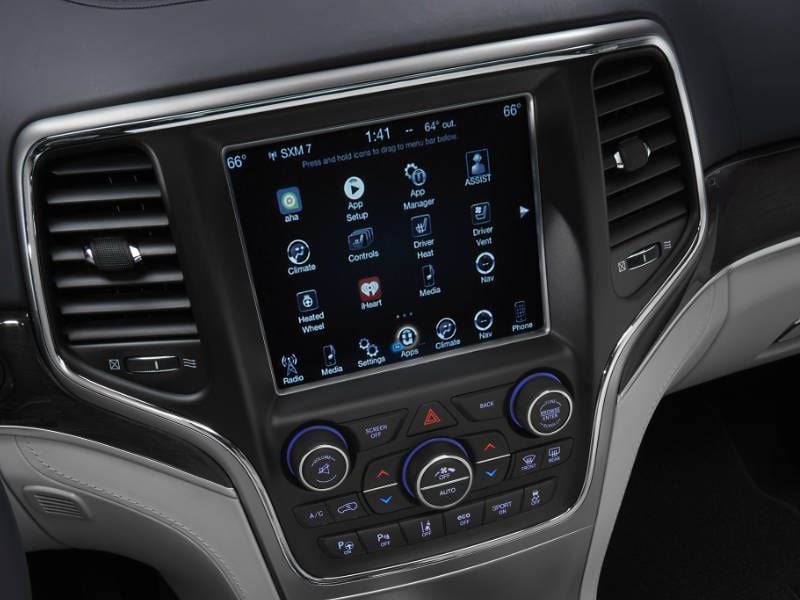
Photo by Jeep
Results
Our final tally indicates the Jeep Grand Cherokee winning six of our nine categories, keeping in mind that Ford’s victory in EPA ratings were a pretty close call. It all adds up to an overall win for the Jeep with one major caveat - if you absolutely have to fit seven occupants, your only choice is the Explorer.
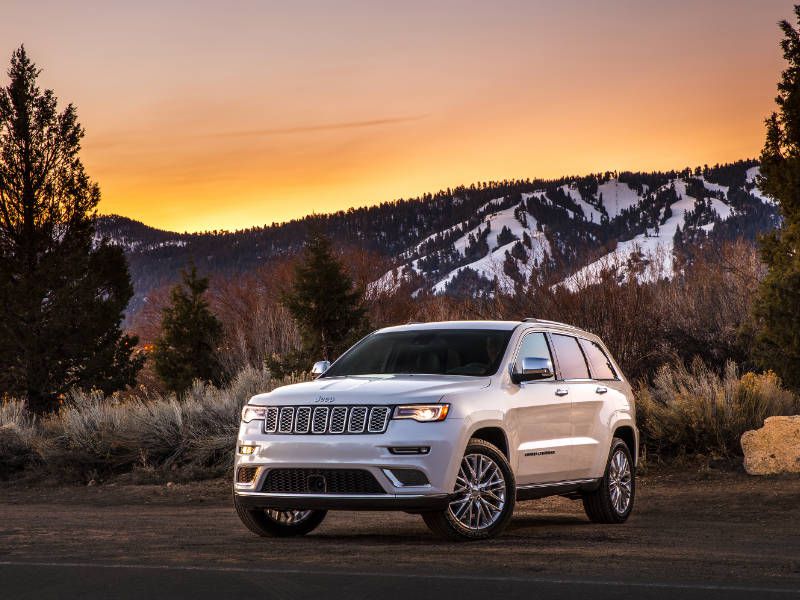
Photo by Jeep